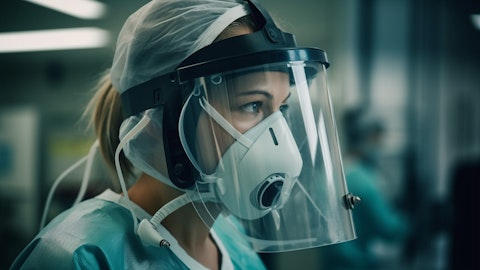That was the word he used. So you can use – and he’s the PI on this study. You can use his thoughts to what he thinks between the PAP arm and the non-PAP arm. So he’s sort of leaning towards what he said earlier, that best treatment for sleep apnea is not a) weight loss or b) CPAP, it’s a plus b. And so that’s what I expect this study to show. And we’ll see the data. They will be out there in three weeks and whatever they want to release in headline and we’ll continue to go. We’ll continue to grow. We’ll continue to drive patients into the funnel, and I think this therapeutic class will help us over the coming decade to bring more patients into the funnel.
Operator: Thank you. Next question today is coming from Lyanne Harrison from Bank of America. Your line is now live.
Lyanne Harrison: Yes. Good morning, Mike. So, Mick, Brett, and Amy. I might ask a question about your device and mask sales there. So obviously, strong device sales, your resupply programs, obviously, giving that some focus. But masks this quarter came out weaker than where we expected. Can you talk us through where the disconnect there might be?
Michael Farrell: Thanks for the question, Lyanne. And yes, really, really happy to take questions and talk about our devices business and our mask business. So look, devices growth globally, incredibly strong in the quarter at 11%. Masks growth globally incredibly strong at 9%. We talk about the market being mid-single-digit growth for devices, so we’re clearly well ahead of that with the launch of AirSense 11 in Japan and Europe, Asia Rest of World and doing well in the U.S. a couple of hundred basis points above. And then in masks and accessory, you talked about global growth being in high single digits. And so beating that in U.S., Canada, Latin America, but what you’re probably focusing on is the Europe, Asia and Rest of World growth there in Q2 FY2024 being 4%, right?
And just to be clear, the Q2 FY2023 growth in that same category was 14%. And we were taking 500 basis points a share 12 months ago and then losing it this quarter. I really think if you look at the weighted average over that, which is, what, 18 divided by 2 is 9% is sort of more in line with the market growth in that mid- to high single-digit growth of masks there. And look, there’s some things around some contracts with the particular countries that were moved from December to January and others. I’m not going to go to all the details other than to say, we look really closely at share. We look really closely at what we’re doing. And this 90-day snapshot four quarters ago, which showed 14%. We weren’t taking 500 basis points a share. We were holding share, growing in a little – a category here or there.
And now this quarter at 4%, we’re not losing 500 bps a share. We’re actually holding share across that and it’s due to some of those shipping areas – launch areas and frankly, a couple of tenders that will move from one month to another. So really not much to see in that. But what I will say is that as we move forward, maintaining that high single-digit growth in devices globally, and the high – sorry, mid-single-digit growth in devices globally and high single-digit growth in masks globally is not a given. We’ve got to drive that demand. We’ve got to leverage this Big Pharma trend. We’ve got to leverage the big tech trend – and we’ve got to get better at doing demand generation in the areas where we know we can push it up. And so that’s what we’re going to be focused on going forward.
I hope that answers your question, Lyanne.
Operator: Thank you. Our final question today is coming from Michael Polark from Wolfe Research. Your line is now live.
Michael Polark: Hey, good afternoon. I will ask a mask question as well following up there in a slightly different way. So the U.S. number was up 2% sequentially. Normally, you see a high single-digit increase Q-over-Q kind of year-end seasonality in the U.S. deductible flush, that kind of thing. Kind of what are the puts and takes in that number? And the specific question is, did the Magnet field safety notice kind of limit your ability to fully capture mass demand in the quarter? Or were there other influences? Thank you so much.
Michael Farrell: Yes. Great question, Michael. So yes, U.S., Canada and Latin America, a 10% growth in the mask in the quarter. It was actually a very strong market growth rate, high single digits, holding share there. We do see that December, particularly for U.S. markets where high deductibles and deductibles reset December 31, some good revenue there. And so we had good comp from the year before, and both solid numbers there from the comp year before this 10% U.S. Canada Latin America growth. So I think we did really well there as we closed out the quarter. In terms of any impact from the masks with magnets update on our labeling class in the U.S. by the U.S. FDA as a recall. I got to tell you, there was no product removed from the market.
This was about having our plastic clips as an option, which we scaled up manufacturing and have them as an option. So when a patient is set up, if they’re a very, very small minority of people who haven’t implanted pacemaker or other metal device in their upper chest or craniofacial area, then those patients are offered an upgrade to the plastic clips. For everyone else, the other 95%, 99% of patients they keep the convenience of the magnet. So that if they go to the bathroom in the night, they can come back in the dark and just clip it on and not have to seek for plastic clips to click together the magnet completely goes on there. And so as we’ve done that labeling upgrade, and we had a competitor do this similar one about 12 months ago, the market has been very trained in knowing to ask questions about implants to ask questions about our partner’s implants.




